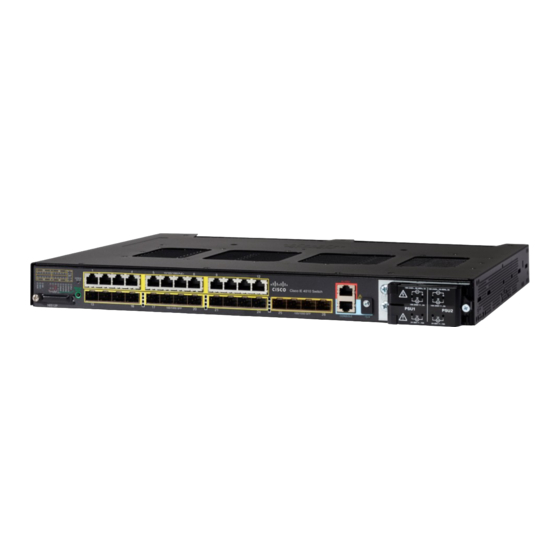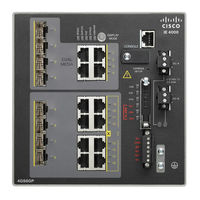
Cisco IE 4010 Manuals
Manuals and User Guides for Cisco IE 4010. We have 4 Cisco IE 4010 manuals available for free PDF download: Software Configuration Manual, Hardware Installation Manual, Product Documentation
Cisco IE 4010 Software Configuration Manual (1066 pages)
Industrial Ethernet Switch
Table of Contents
-
-
Access Ports23
-
Switch Ports23
-
Trunk Ports23
-
Tunnel Ports23
-
-
Routed Ports24
-
-
-
Dns Server69
-
Tftp Server69
-
-
-
Static Addresses113
-
Setting up Dns117
-
Sdm Templates141
-
Radius Operation154
-
Secure Shell165
-
X Host Mode200
-
Mac Move202
-
Host Detection246
-
Session Creation247
-
Supported Vlans276
-
Token Ring Vlans278
-
Deleting a Vlan289
-
Configuring Vtp299
-
Vtp Domain300
-
Vtp Modes301
-
Vtp Version 2302
-
Vtp Version 3303
-
Vtp Pruning304
-
Domain Names306
-
Port-Based Vlans319
-
Blocking State323
-
Listening State323
-
Learning State323
-
Forwarding State323
-
Disabled State324
-
Configuring Mstp337
-
Hop Count340
-
Boundary Ports340
-
Switch Ports344
-
Topology Changes347
-
Bpdu Guard358
-
Bpdu Filtering359
-
Root Guard364
-
Loop Guard365
-
Link Integrity371
-
Fast Convergence371
-
Rep Ports373
-
Configuring Dhcp393
-
Dhcp Server393
-
Dhcp Relay Agent393
-
Routed Ports429
-
Igmp Versions430
-
Immediate Leave432
-
-
Switch Ports436
-
Vlan440
-
Vlan441
-
Vlan442
-
Vlan443
-
Vlan445
-
Storm Control451
-
Protected Ports453
-
Local Span469
-
Remote Span470
-
Span Sessions471
-
Source Ports473
-
Source Vlans474
-
Vlan Filtering474
-
Destination Port474
-
Rspan Vlan475
-
Enabling Lldp495
-
Configuring Cdp503
-
Configuring Udld507
-
Configuring Rmon513
-
Log Messages520
-
Configuring Snmp531
-
Snmp Versions532
-
Supported Acls549
-
Port Acls550
-
Ipv4 Acls551
-
Acl Logging553
-
Modular Qos Cli576
-
Class Maps580
-
Table Maps587
-
Traffic Shaping598
-
Priority Queuing600
-
Qos Statistics650
-
Igmp Version 1680
-
Igmp Version 2681
-
Pim Versions681
-
Pim Modes682
-
Pim Stub Routing682
-
Igmp Helper683
-
Bootstrap Router684
-
Ssm Operations686
-
Msdp Operation736
-
Msdp Benefits737
-
Using a Filter746
-
Mld Messages758
-
Mld Queries758
-
Mld Reports759
-
Hsrp Versions773
-
Multiple Hsrp773
-
Configuring Hsrp774
-
Enabling Hsrp776
-
Configuring Vrrp782
-
Event Detectors794
-
Proxy Arp811
-
Default Gateway811
-
Configuring Rip821
-
Configuring Ospf827
-
Monitoring Ospf841
-
Configuring Bgp850
-
Configuring Bfd887
-
Configuring Vrfs901
-
Enabling Pbr921
-
Rip for Ipv6935
-
Ospf for Ipv6935
-
Eigrp Ipv6935
-
Configuring Ipv6938
-
Dying Gasp977
-
Copying Files1001
-
Deleting Files1002
-
Creating a Tar File1002
-
Pagp Modes1033
-
Lacp Modes1035
-
Etherchannel on Mode1037
-
Troubleshooting1047
-
Cpu Utilization1051
-
Executing Ping1054
-
Advertisement
Cisco IE 4010 Hardware Installation Manual (86 pages)
Table of Contents
-
Alarms10
-
Port Leds13
-
Alarm Leds16
-
Usb Led17
-
System LED17
-
Warnings21
-
Switch Leds55
-
Link Status56
-
SFP Module57
-
Console Port68
-
Alarm Port69
Cisco IE 4010 Hardware Installation Manual (76 pages)
Table of Contents
-
Port Leds10
-
Alarm Leds13
-
System Led14
-
Warnings17
-
-
Switch Leds49
-
Link Status50
-
Sfp Module50
-
Console Port58
-
Alarm Port58
Advertisement



